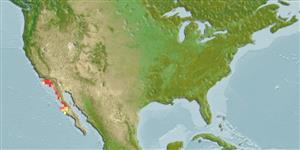Common names from other countries
Environment: milieu / climate zone / depth range / distribution range
Ecologia
; intervalo de profundidade 20 - 66 m (Ref. 101453), usually 43 - 60 m (Ref. 101453). Subtropical; 34°N - 26°N, 121°W - 112°W
Eastern Pacific: USA to Mexico. From Point Conception, California to Punta Abreojos in Baja California.
Length at first maturity / Tamanho / Peso / Idade
Maturity: Lm ?, range 9 - 13.4 cm Max length : 25.0 cm TL macho/indeterminado; (Ref. 865); Idade máx. registada: 40 anos (Ref. 105226)
Historically, found at depths between 25 and 30 m and reported to be formerly common in depths of 10 to 20 m (Ref. 101453). Minimum depth from Ref. 106850. Sedentary (Ref. 106850). Found in open low relief rock or boulder habitat surrounded by sand, often at the sand-rock interface (Ref. 101461). Also occurs in open, exposed deep-water reefs with kelp understory (Ref. 106850). Feeds on drift macroalgae and attached red algae (Ref. 101622).
Broadcast spawners. Life cycle: Embryos develop into planktonic trocophore larvae and later into juvenile veligers before becoming fully grown adults (Ref. 833). Also Refs. 105220, 105232.
Bisby, F.A., M.A. Ruggiero, K.L. Wilson, M. Cachuela-Palacio, S.W. Kimani, Y.R. Roskov, A. Soulier-Perkins and J. van Hertum. 2005. (Ref. 19)
Categoria na Lista Vermelha da IUCN (Ref. 130435)
Categoria CITES (Ref. 108899)
Not Evaluated
Not Evaluated
Utilização humana
Pescarias: espécies comerciais
| FishSource |
Ferramentas
Fontes da internet
Estimates based on models
